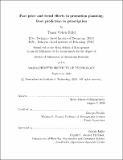| dc.contributor.advisor | Georgia Perakis. | en_US |
| dc.contributor.author | Cohen-Hillel, Tamar. | en_US |
| dc.contributor.other | Massachusetts Institute of Technology. Operations Research Center. | en_US |
| dc.date.accessioned | 2021-01-05T23:14:09Z | |
| dc.date.available | 2021-01-05T23:14:09Z | |
| dc.date.copyright | 2020 | en_US |
| dc.date.issued | 2020 | en_US |
| dc.identifier.uri | https://hdl.handle.net/1721.1/129030 | |
| dc.description | Thesis: Ph. D., Massachusetts Institute of Technology, Sloan School of Management, Operations Research Center, September, 2020 | en_US |
| dc.description | Cataloged from student-submitted PDF of thesis. | en_US |
| dc.description | Includes bibliographical references (pages 261-268). | en_US |
| dc.description.abstract | Sales promotions are a popular type of marketing strategy. When undertaking a sales promotion, products are promoted using short-term price reductions to stimulate their demand and increase their sales. These sales promotions are widely used in practice by retailers. When undertaking a sales promotion, retailers must take into consideration both the direct and indirect effects of price promotions on consumers, and as a result, on the demand. In this thesis, we consider the impact of two of these indirect effects on the planning process of promotions. First, we consider the problem of the promotion planning process for fast-moving consumer goods. The main challenge when considering the promotion planning problem for fast-moving consumer goods is the negative indirect effect of promotions on future sales. While temporary price reductions substantially increase demand, in the following periods after a temporary price reduction, retailers observe a slowdown in sales. | en_US |
| dc.description.abstract | To capture this post promotion slowdown, we suggest a new set of past prices (namely, the last seen as well as the minimum price seen within a limited number of past periods) as features in the demand model. We refer to demand models that use this set of past prices as Bounded Memory Peak-End models. When tested on realworld data, our suggested demand model improved the estimation quality relative to a traditional estimation approach through a relative improvement in WMAPE by approximately 1 - 19%. In addition to the improvement in prediction accuracy, we analyze the sensitivity of our proposed Bounded Memory Peak-End demand model to demand misspecification. Through statistical analysis, and using principles from duality theory, we establish that even in the face of demand misspecification, the proposed Bounded Memory Peak-End model can capture the demand with provably low estimation error, and with low impact on the resulting optimal pricing policy. | en_US |
| dc.description.abstract | The structure of the new proposed demand model allows us to derive fast algorithms that can find the optimal solution to the problem of promotion planning for a single item. For the case of promotion planning for multiple items, although we show that the problem is NP-hard in the strong sense, we propose a Polynomial Time Approximation Scheme that can solve the problem efficiently. Overall, we show that using our proposed approach, the retailer can obtain an increase of 4 - 15.6% in profit compared to current practice. Second, we consider the promotion targeting problem for trendy commodities. In the case of trendy commodities, the demand is driven, among other factors, by social trends. Examples of trendy commodities include fashion items, wearable electronics, and smartphones. To capture the demand with high accuracy, retailers must understand how the purchasing behavior of customers can impact the future purchasing behavior of other customers. | en_US |
| dc.description.abstract | Social media can be instrumental in learning how consumers can impose trends on one another. Unfortunately, many retailers are unable to obtain this information due to high costs and privacy issues. This has motivated us to develop a model that detects customer relationships based only on transaction data history. Incorporating the customer to customer trend in the demand estimation, we observe a significant improvement of 12% in the WMAPE forecasting metric. The proposed customer to customer trend-based demand model subsequently allows us to formulate the promotion targeting optimization problem in a way that consider the indirect effect of targeted promotions through trends. We show that the problem of finding the personalized promotion policy that would maximize the profit function is NP-hard. Nonetheless, we introduce an adaptive greedy algorithm that is intuitive to implement and can find a provably near-optimal personalized promotion policy. | en_US |
| dc.description.abstract | We tested our approach on Oracle data and observed a 5-12% improvement in terms of profit. | en_US |
| dc.description.statementofresponsibility | by Tamar Cohen-Hillel. | en_US |
| dc.format.extent | 268 pages | en_US |
| dc.language.iso | eng | en_US |
| dc.publisher | Massachusetts Institute of Technology | en_US |
| dc.rights | MIT theses may be protected by copyright. Please reuse MIT thesis content according to the MIT Libraries Permissions Policy, which is available through the URL provided. | en_US |
| dc.rights.uri | http://dspace.mit.edu/handle/1721.1/7582 | en_US |
| dc.subject | Operations Research Center. | en_US |
| dc.title | Past price and trend effects in promotion planning; from prediction to prescription | en_US |
| dc.type | Thesis | en_US |
| dc.description.degree | Ph. D. | en_US |
| dc.contributor.department | Massachusetts Institute of Technology. Operations Research Center | en_US |
| dc.contributor.department | Sloan School of Management | |
| dc.identifier.oclc | 1227044412 | en_US |
| dc.description.collection | Ph.D. Massachusetts Institute of Technology, Sloan School of Management, Operations Research Center | en_US |
| dspace.imported | 2021-01-05T23:14:08Z | en_US |
| mit.thesis.degree | Doctoral | en_US |
| mit.thesis.department | Sloan | en_US |
| mit.thesis.department | OperRes | en_US |
